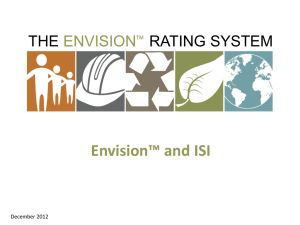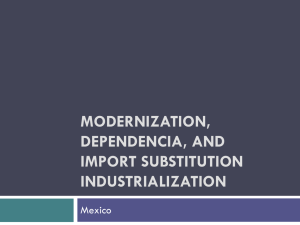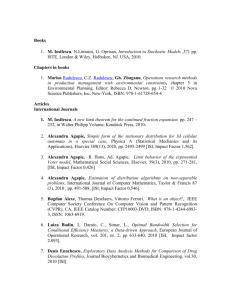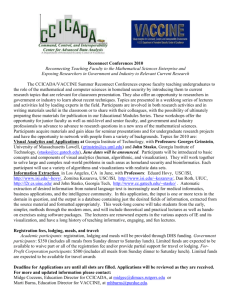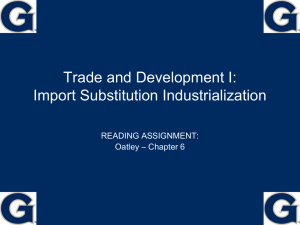PEGS Lecture 7 State-led Devpmt
advertisement
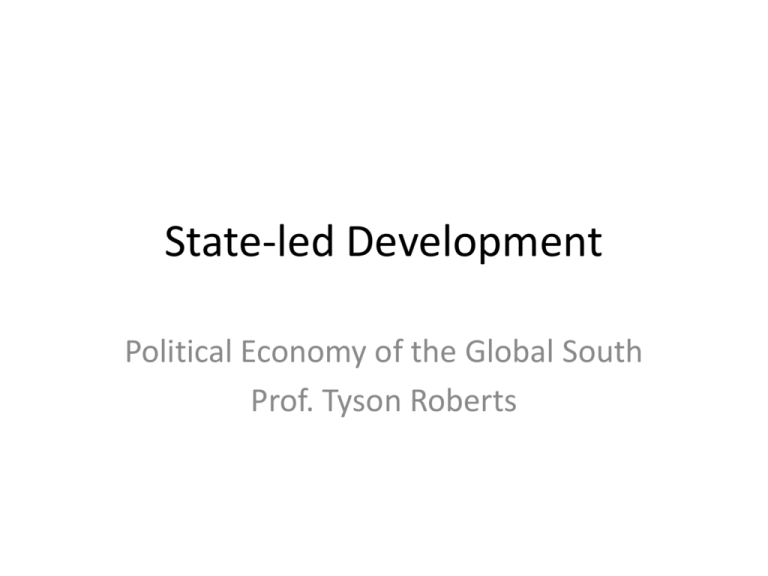
State-led Development Political Economy of the Global South Prof. Tyson Roberts Mobutu Surprise Pop Quiz! 1. What TV broadcast was Mobutu upset about? 2. What happened when Mobutu watched a missile launch test? 3. True or False: Mobutu sometimes slept with the wives of his top officials. 4. What are some of the economic policies of Zairinization? 5. What would happen when Mobutu would ask his officials to get him a million dollars? Trivia Quiz 1. What does “ISI” stand for? – Import-Substituting Industrialization 2. Name two policies that are part of ISI 3. What is “state capitalism”? – The state controls the “commanding heights” of the economy such as transportation and energy; other parts of the economy can be private 4. Does the Washington Consensus favor or oppose ISI policies? – Oppose How globalization helps developing countries according to classical liberalism • Free trade: poor countries specialize in comparative advantage (e.g., agriculture) & import other products (e.g., manufactures) => production • Free flow of labor: workers move from laborabundant to labor-scarce economies => wages • Free flow of capital: capital flows freely from capitalrich to capital scarce countries => investment, development Development philosophy 1950s-1970s: “The Big Push” • Marshall Plan big success in Europe; apply same strategy to developing world – “the tricks of growth are not that difficult” (Rostow 1960) • Diagnosis: countries poor because agriculture based, insufficient capital – Private financial sector not sufficiently dev’ped; wealthy class in poor countries consume rather than invest • Solution: capital transfers to poor country governments to finance industrialization Growth Model Review Part 1 • Harrod-Domar Model: – y=f(k) – Constant returns to capital – Growth determined by savings rate What might justify ignoring labor in a growth model? What might justify ignoring labor in a growth model? • Lewis: In developing countries, an increase in capital attracts labor from subsistence farming without reducing agricultural output – In short run, no increase in wages – In long run, profits from capital can be invested, leading to self-sustaining economic development – When subsistence labor is absorbed in modern economy, wages begin to increase What might justify ignoring technology in a growth model? • Sources of technological improvements: – Adoption – Innovation • Developing countries can adopt technologies from advanced countries as they increase their capital stock Growth Model Review Part 1 • Harrod-Domar Model: – y=f(k) – Constant returns to capital – Growth determined by savings rate Mathematical example Harrod-Domar • • • • If f(k) = 5k, and k =10, what is y? y = 5 x 10 = 50 Now suppose k = 20. What is y? y = 5 x 20 = 100 • Constant returns to capital – if capital is doubled, output doubles Savings and Harrod-Domar • Poor countries can draw on savings from rich countries (aid, loans, or investment) to increase capital • As income increases, more domestic savings become available to invest in capital The plan: invested capital => industrialization => Take-off, following the West Economic policy in post-independence Ghana • Cocoa Marketing Board – Originally answer to volatility Marketing Boards (or Stabilization Boards) shielded farmers from volatility in world markets Economic policy in post-independence Ghana • Cocoa Marketing Board – Originally answer to volatility – Became source of capital for industrialization • Other boards created – Exports: timber, etc. – Domestic markets: food, etc. • Industrial projects included hydropower dam, aluminum smelter plant, coconut oil mill, sugar estates, tomato cannery, etc. Structuralist Critique of Economic Liberalism • Market imperfections in developing countries – Industrialization in modern era requires coordination • Complementary demand: need critical mass of wage workers to buy manufactured products • Pecuniary external demand: need related industries to invest simultaneously Solution to coordination problem: “Big Push” by Government Volta Dam, Ghana Major electricity producer Valco aluminum smelter Major electricity user Structuralist Critique of Economic Liberalism • Market imperfections in developing countries – Industrialization in modern era requires coordination – Declining terms of trade • Imported manufactures prices rise • Export commodity prices fall • Result: core country real incomes rise, periphery country real incomes fall Specialization in sugar enriched countries such as Haiti in the short run but undermined long-run growth Solution to Declining Terms of Trade Problem: ISI 1. Easy ISI: – Promote local production of consumer goods • Sufficient local demand to enable economies of scale • Sufficient local labor for labor intensive production • Necessary technology available for import (in part in form of foreign capital: machines, etc.) • Benefits: wage-based employment, human capital Solution to Declining Terms of Trade Problem: ISI 1. Easy ISI 2. Second step options – Secondary ISI • • Move up to consumer durables (cars, etc.), intermediate inputs (steel, etc.), and capital goods (machines, etc.) Common in Latin America, South Asia, etc. – Export substitution • • Expand consumer good production for export Common in some East Asian countries ISI Policies • Government planning (5-year plans, etc.) • Government investment – Roads, rail, electricity, telecom, etc. – State-owned & mixed-ownership enterprises • Trade barriers – Tariffs (on manufactured goods) – Import quotas (on manufactured goods) – Overvalued and/or multitiered exchange rates to enable import of capital goods Sources of funds for investment • Foreign aid • Foreign borrowing • Taxes on agricultural exports (marketing boards) • Tariffs on imports $2 $1 $1 Winners & Losers from ISI Policies Winners • Workers & firms in importcompeting industries – Higher market share & prices for produced goods • Government – Jobs, opportunities for rentseeking • Urban residents – Subsidized government services Losers • Export-oriented farmers – Lower producer prices => reduced production • Consumers – Higher prices for manufactured goods • Manufacturers in exportoriented industries (if any) – Overvalued exchange rates increase price of exports, etc. Interest group politics Urban bias • Urban citizens tend to be more politically active than rural citizens – Lower transaction costs, collective action costs • Nkrumah’s policies favored urban groups over farmers, increasing the share of national resources held by urban groups • Urban groups use resources to push for more pro-urban policies (including supporting inefficient SOEs) ISI policies successfully promoted industrialization & GDP growth in 60s & 70s GDP/capita growth 1960s & 70s Latin America 2.3% Sub-Saharan Africa 1.4% Middle East & N. Africa 3.7% East Asia 5.2 % South Asia 1.2% Southeast Asia 3.1% But for most countries (all but East Asia), those growth rates would not prove sustainable… Ghana’s producer price was consistently below the international price from the mid-1950s – 1980s Underpaid farmers reduced investment in cocoa plantations When trees started to die ~1970, output fell for 15 years Cocoa production dominance switched hands from Ghana to Cote d’Ivoire, where producers were better paid Real GDP per capita, Ghana vs. Cote d’Ivoire, 1955-1979 The Ivoirien Miracle Revenues from growth spent on ISI projects, political support, and vanity projects Revenues from growth spent on ISI project, political support, and vanity projects Other ISI policies: Tariffs and import quotas • Increases price of imports; enables local producers to charge higher prices • Government receives revenues from tariffs • Producers sell more, but can remain inefficient • Spending on lobbying for more protections and benefits more lucrative than investment in increased productivity Other ISI policies Overvaluation of currency • Reduces cost of capital and inputs for industrialization • Reduces import costs for (urban) consumers • Increases cost of exports on world markets • Excessive demand for foreign currency drains reserves • Foreign currency then become scarce – Encourages patronage and corruption – Increases black market prices, which encourages economic activity to move to the black market Growth Model Review Part 2 • Solow Model (based on Cobb-Douglas) – y = Akαlβ ; α + β = 1 – Diminishing returns to capital & labor – Growth determined by technology East Asian Miracles • Government built and ran state-owned plants (higher technology) – later privatized. • Government subsidies for favored industries – Included some agricultural sectors • High tariffs on industrial products – later reduced. • Infant industries grew under protection selling to local consumers, then began to export • Outward-orientation ensured high levels of productivity – But undervalued currencies reduced consumption levels of citizens in short term – still the case (until recently?) in China African failures • Government built and ran state-owned plants • Government subsidies for favored industries – Agriculture cash cows milked for investment in factories • High tariffs on manufacture imports • Infant industries were inefficient, generated losses • Overvalued currencies enabled higher consumption levels for citizens in short term – But local firms uncompetitive relative to foreign firms • Eventually, trade deficits & budget deficits forced governments to accept structural adjustment conditions – privatization, trade liberalization, etc. Why did African countries pursue poor policies? Conclusions • International and domestic developments and new belief systems => ISI Policies – World Wars & Depression strengthened relatively scarce factor owners – Political changes strengthened workers, domestic industrialists, urban voters, etc. – Marxism, Structuralist critique of economic liberalism, etc. Conclusions • ISI policies increased industrialization & GDP growth, but … • Urban workers & industrialists benefitted to detriment of export-oriented farmers • Governments (esp. in “weak states”) took advantage of rent-seeking opportunities to over-extend protection of inefficient manufacturers • Budget & trade deficits left countries exposed to global economic crises • Some Asian Miracle countries used ISI policies for “easy ISI” then opened to trade for “export-led industrialization”
